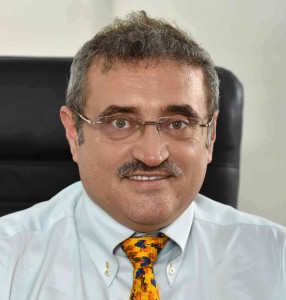:quality(80)/business-review.eu/wp-content/uploads/2017/07/Alba_Iulia_viziune_Smart_City.jpg)
The development of Alba Iulia under the smart city principles could yield total benefits of EUR 532 million over the course of 35 years, according to a new study by German engineering group Siemens.
The company assessed the direct and indirect benefits of investments in smart cities for Alba-Iulia, Aberdeen and London (UK), Bruxelles (Belgium) and Kartal neighborhood (Turkey). Siemens worked on the report in partnership with ARUP.
“At this moment, there are close to 300 smart lighting systems. It’s an exercise to see that we can do things differently, and of course things will move forward,” said the mayor of Alba Iulia, Mircea Hava.
George Costache, CEO of Siemens Romania, explained that the digitalization will certainly change the urban infrastructure.
“The fourth industrial revolution will integrate the digital innovation for cities. When it comes to urban infrastructure, cities have to be interested in mobility, energy and smart buildings. The digitalization allows the predictable maintenance,” said Costache.
“Most of the smart cities apps up to now focused until
now only on the optimization of resources and this will change. The Internet of Things (IoT) will evolve towards an interconnected system that will bring together different individual apps, to enhance the development of cities by combining and filtering data,” said the CEO.
Costache said the citizen has to be a partner under the smart cities principles. He added that the massive amounts of data generated by smart cities need to get to the citizens as information that they need.
According to the report, Alba-Iulia should invest EUR 227 million in smart technologies to get more than half a billion euros in benefits in 35 years. The payback period for the investment would stand at 10 years.
The three sectors of interest identified for Alba Iulia are connectivity, transport and energy
The smart energy infrastructure would require the biggest initial investment of EUR 215 million over four year, and the study points out that the cumulative direct and indirect benefit after 35 years would reach EUR 426 million. In addition, the city would continue to register annually EUR 34 million in direct and indirect benefit after this period.
The study points out that the investments in smart grids and street lighting control would provide energy efficiency on the long term, which would help the municipality reduce its operational budget.
On smart connectivity, the city could invest in free Wi-Fi, integrated visitor platform, expanded e-bike rental scheme, geospatial beacons and augmented reality and e-ticketing for public transport. The initial investment over four years would stand at EUR 6.7 million, while the cumulative net direct and indirect benefit by the end of the 35-year period would reach EUR 70 million. After this period, the city would continue to get EUR 4.3 million yearly through direct and indirect benefits.
On smart transport, the municipality could attract investments in operational sensors, real time journey planning and smart parking management. Siemens forecasted that an initial investment of EUR 5 million over four years would generate direct and direct benefits worth EUR 35 million. The investments would continue to generate EUR 1.7 million annually in direct and indirect benefit after this period.
“These are all quite cautious figures, we have not been overenthusiastic,” said Julie Alexander, director of the urban development department at Siemens in London and coordinator of the research.
Financing these investment would include a public component, according to representatives of Alba Iulia City Hall.
Alba Iulia municipality plans investments in transport infrastructure and energy efficiency
Nicolaie Moldovan, the city manager of Alba Iulia, says that around the municipality is currently looking to secure financing for investments worth EUR 22 million in the transport infrastructure. This would include the modernization of roads, the deployment of smart traffic lights systems and special bike lanes.
Furthermore, the municipality wants to invest up to EUR 16 million in the thermal rehabilitation of 30 apartment blocks.
Moldovan said the city is also exploring investments in Virtual Reality/Augmented Reality projects, mainly for the Alba Carolina fortress, the main tourist attraction in the city.
On the development under smart cities principles, Moldovan said that there are 48 pilot projects that would be jointly developed with the private sector.
The report by Siemens includes a various financing mechanisms that are usually deployed by municipalities looking to invest in smart tech. Among them there is the performance contracting, the public-private partnerships, smart bonds and tax incremental financing.
Quick facts about Alba Iulia
The city is located in western Romania, in the Transylvanian region. The city hosted the signing of the declaration of the great union of Romania from December 1 1918.
The city has 63,500 inhabitants, while the whole population of the Alba region stands at 333,524.
The gross value added of the city stands at EUR 2.2 billion.
Cars and buses are the most popular means of transport in the city.



:quality(80)/business-review.eu/wp-content/uploads/2024/02/The-Transylvania-Princes-Palace.jpeg)




:quality(80)/business-review.eu/wp-content/uploads/2024/06/22C0420_006.jpg)

:quality(80)/business-review.eu/wp-content/uploads/2024/06/COVER-1-4.jpg)



:quality(50)/business-review.eu/wp-content/uploads/2023/09/Smart-home-cu-panorama-superba-in-Alba-Iulia-1.jpg)
:quality(80)/business-review.eu/wp-content/uploads/2024/06/br-june-2.jpg)
:quality(50)/business-review.eu/wp-content/uploads/2024/07/Ilustratie-2.jpg)
:quality(50)/business-review.eu/wp-content/uploads/2024/07/VGP-Park-Timisoara_-8thbuilding_iulie-24.jpg)
:quality(50)/business-review.eu/wp-content/uploads/2024/07/America-House-Offices-Bucharest-Fortim-Trusted-Advisors.jpg)